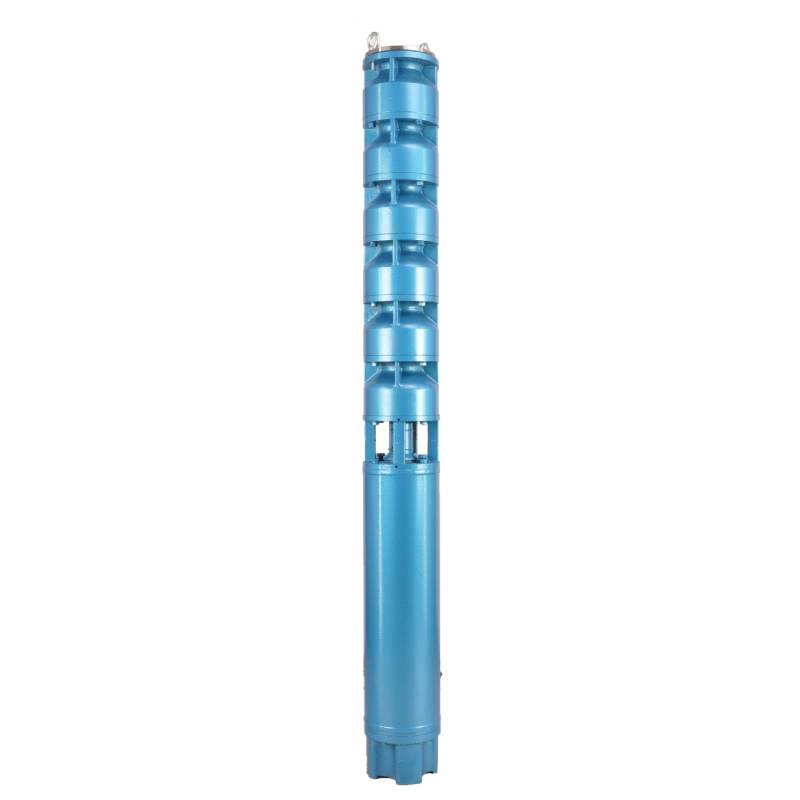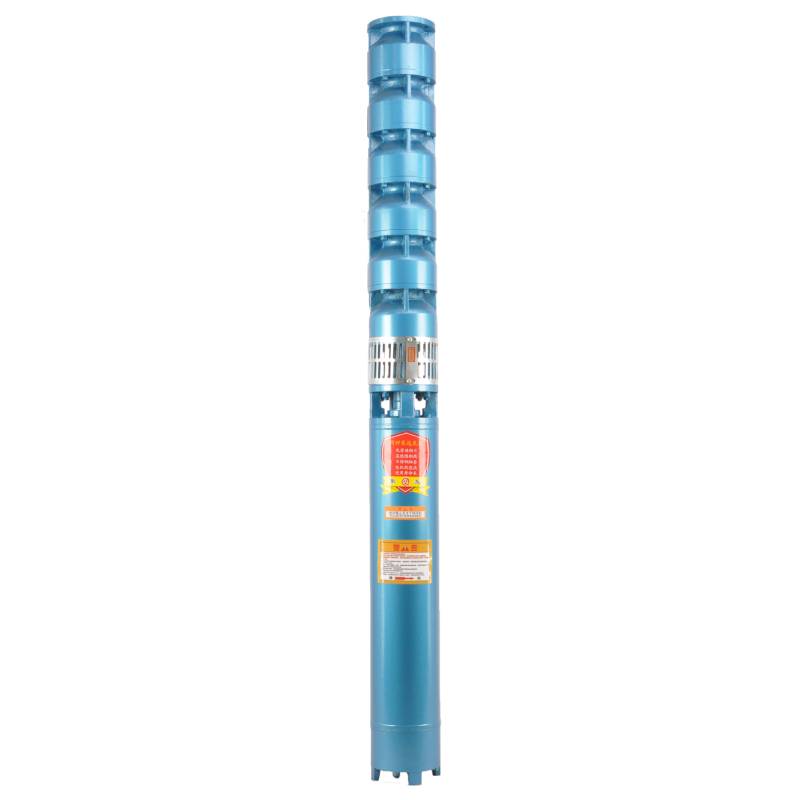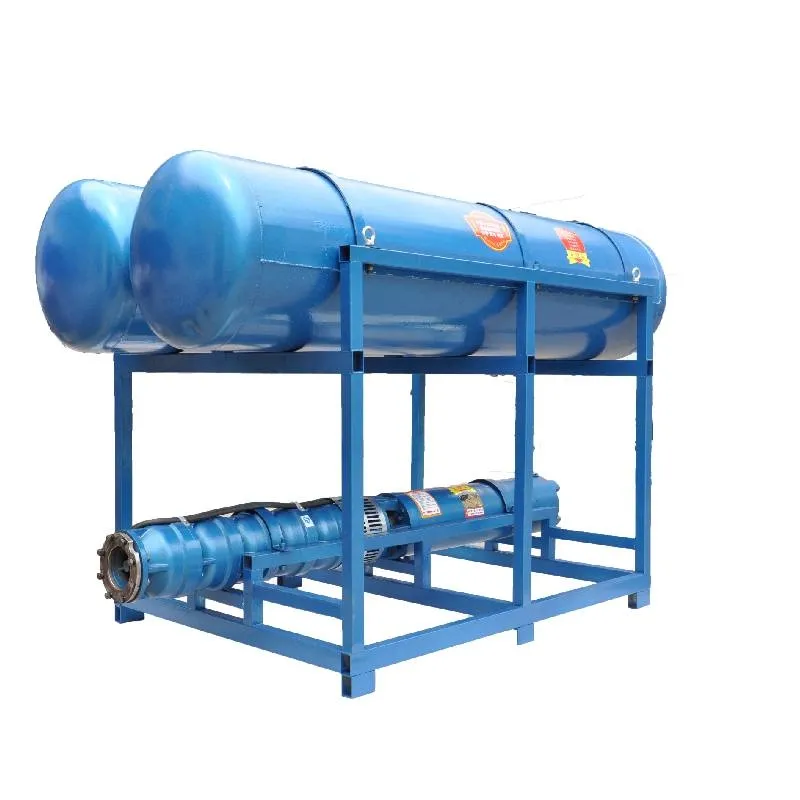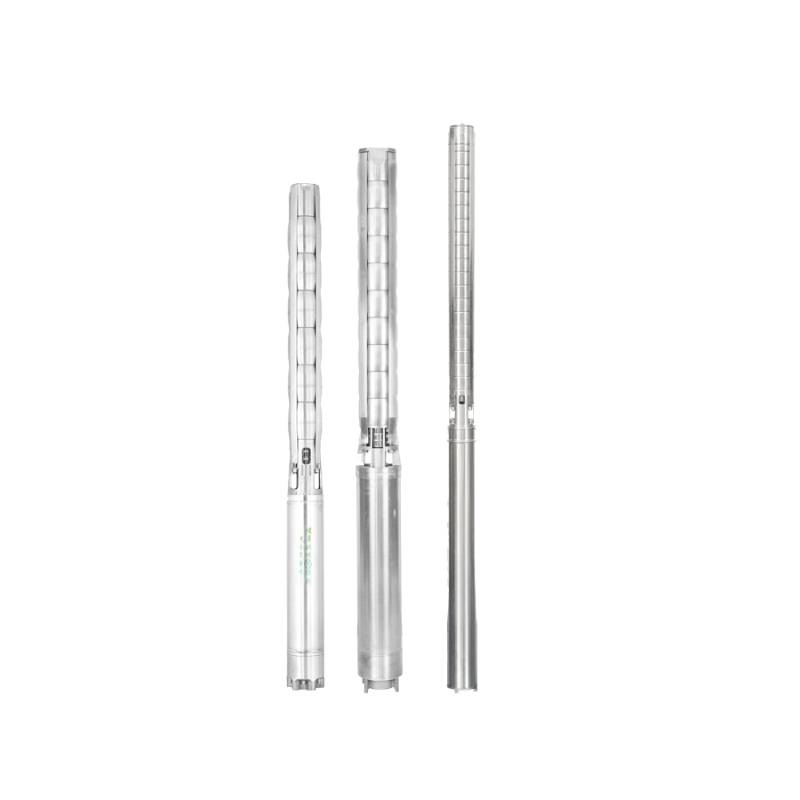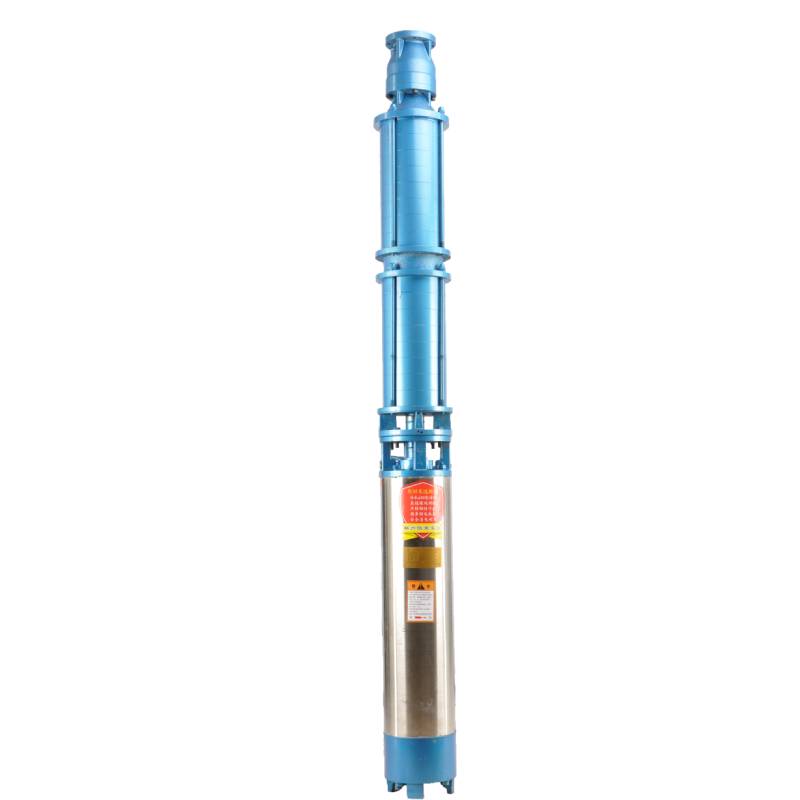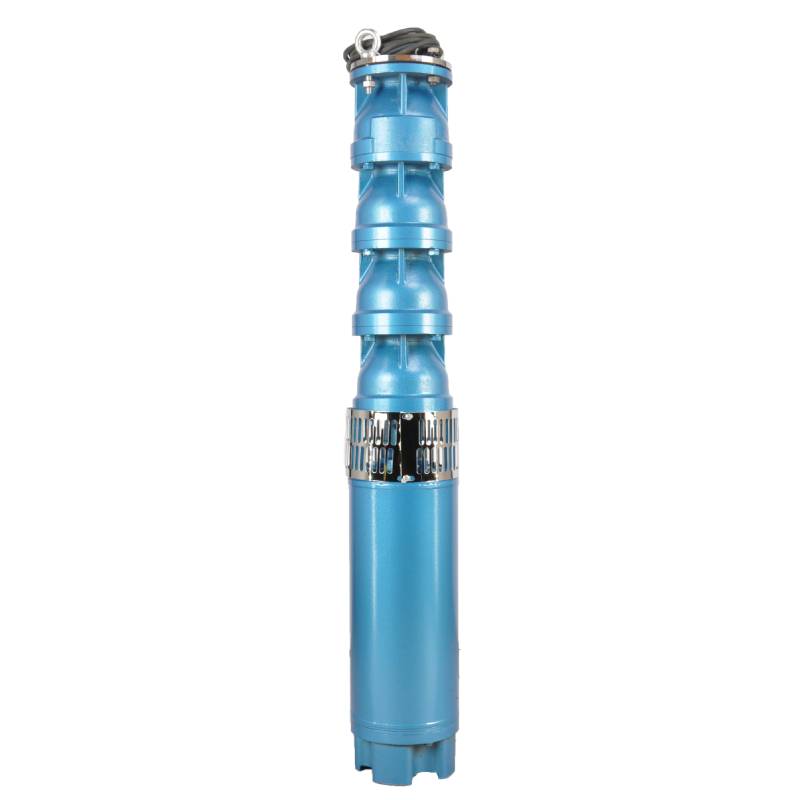QJ series submersible pump is a kind of water lifting equipment directly connected to the submersible motor and pump to work in the water. This series of pumps are vertical, with small use area, compact structure, simple installation, convenient maintenance and repair. It is widely used in agricultural irrigation, municipal engineering, water conservancy engineering, urban water supply and drainage, industrial and mining enterprises water supply and drainage, drought relief and flood relief and so on. The flow range is 5-500m3/h, the head is 4-800m, and the power is 3-315KW. This product has stable and reliable performance, can meet the needs of various different uses of pumps, and is one of the excellent choices in the market.
This product is a three-phase AC 380V electric pump, suitable for various pump applications. The power supply requirements for ± 5% of the three-phase AC 380V voltage, 50HZ frequency fluctuation range of ± 1%. Water quality requirements include water temperature not higher than 20 °C, solid impurities content (mass ratio) is not greater than 0.01%, PH value of 6.5-8.5, hydrogen sulfide content is not greater than 1.5mg/L, chloride ion content is not greater than 400mg/L. The motor adopts a closed or water injection wet structure, before use must be submersible motor inner cavity filled with clean water to prevent empty, while fastening the water injection and pressure relief bolts, otherwise not to use. Submersible pump must be completely immersed in water work, immersion depth shall not exceed 70 meters, the distance from the bottom of the pump to the bottom of the well shall not be less than 3 meters. Well water inflow shall meet the water output and continuous operation requirements of submersible pump, pump output shall be controlled at 0.7-1.2 times the rated flow. The well must be vertical, submersible pump can not be used horizontally or tilted, only vertical use. Submersible pump must be equipped with cables as required, and equipped with external overload protection device. It is strictly prohibited to do no-load test without water.

| Hoʻohālike | Kahe (m3/h) | Poʻo (m) |
Rotatingspeed(change/point) | Pum wai(%) | puka puka anawaena (mm) |
Kūpono maikaʻi anawaena(mm) |
Heluhelu ʻia power(KW) |
Heluhelu ʻia uila (V) |
Heluhelu ʻia kēia manawa(A) |
Kaʻa kaʻa (%) | power factorcosφ | Unite Ka nui o ka Radial (mm) |
|||||||||
| 175QJ10-42 | 10 | 42 | 2850 | 53 | 50 | 175maluna | 3 | 380 | 7.8 | 74.0 | 0.79 | 168 | |||||||||
| 175QJ10-56 | 56 | 4 | 10.1 | 76.0 | 0.79 | ||||||||||||||||
| 175QJ10-70 | 70 | 4 | 10.1 | 76.0 | 0.79 | ||||||||||||||||
| 175QJ10-84 | 84 | 5.5 | 13.6 | 77.0 | 0.8 | ||||||||||||||||
| 175QJ10-112 | 112 | 7.5 | 18.4 | 77.5 | 0.8 | ||||||||||||||||
| 175QJ10-126 | 126 | 7.5 | 18.4 | 77.5 | 0.8 | ||||||||||||||||
| 175QJ10-140 | 140 | 9.2 | 22.1 | 78.0 | 0.81 | ||||||||||||||||
| 175QJ15-42 | 15 | 42 | 2850 | 58 | 50 | 175maluna | 4 | 380 | 10.1 | 76.0 | 0.79 | 168 | |||||||||
| 175QJ15-55 | 55 | 5.5 | 13.6 | 77.0 | 0.8 | ||||||||||||||||
| 175QJ15-65 | 65 | 5.5 | 13.6 | 77.0 | 0.8 | ||||||||||||||||
| 175QJ15-85 | 85 | 7.5 | 18.4 | 77.5 | 0.8 | ||||||||||||||||
| 175QJ15-112 | 112 | 9.2 | 22.1 | 78.0 | 0.81 | ||||||||||||||||
| 175QJ20-26 | 20 | 26 | 2850 | 64 | 50 | 175maluna | 3 | 380 | 7.8 | 74.0 | 0.79 | 168 | |||||||||
| 175QJ20-39 | 39 | 4 | 10.1 | 76.0 | 0.79 | ||||||||||||||||
| 175QJ20-52 | 52 | 5.5 | 13.6 | 77.0 | 0.8 | ||||||||||||||||
| 175QJ20-78 | 78 | 7.5 | 18.4 | 77.5 | 0.8 | ||||||||||||||||
| 175QJ20-91 | 91 | 9.2 | 22.1 | 78.0 | 0.81 | ||||||||||||||||
| 175QJ20-104 | 104 | 11 | 26.1 | 79.0 | 0.81 | ||||||||||||||||
| 175QJ20-130 | 130 | 13 | 30.1 | 80.0 | 0.82 | ||||||||||||||||
| 175QJ20-156 | 156 | 15 | 34.7 | 80.0 | 0.82 | ||||||||||||||||
| 175QJ20-182 | 187 | 18.5 | 42.6 | 80.5 | 0.82 | ||||||||||||||||
| 175QJ20-208 | 208 | 22 | 49.7 | 81.0 | 0.83 | ||||||||||||||||
| 175QJ20-247 | 247 | 25 | 56.5 | 81.0 | 0.83 | ||||||||||||||||
| 175QJ20-273 | 273 | 30 | 66.6 | 81.5 | 0.84 | ||||||||||||||||
| 175QJ20-299 | 299 | 30 | 66.6 | 81.5 | 0.84 | ||||||||||||||||
| 175QJ20-325 | 325 | 32 | 71.0 | 81.5 | 0.84 | ||||||||||||||||
| 175QJ20-364 | 364 | 37 | 82.1 | 81.5 | 0.84 | ||||||||||||||||
| 175QJ25-26 | 25 | 26 | 2850 | 66 | 65 | 175maluna | 3 | 380 | 7.8 | 74.0 | 0.79 | 168 | |||||||||
| 175QJ25-39 | 39 | 5.5 | 13.6 | 77.0 | 0.8 | ||||||||||||||||
| 175QJ25-65 | 25 | 65 | 2850 | 66 | 65 | 175maluna | 7.5 | 380 | 18.4 | 77.5 | 0.8 | 168 | |||||||||
| 175QJ25-78 | 78 | 9.2 | 22.1 | 78.0 | 0.81 | ||||||||||||||||
| 175QJ25-91 | 91 | 11 | 26.1 | 79.0 | 0.81 | ||||||||||||||||
| 175QJ25-104 | 104 | 13 | 30.1 | 80.0 | 0.82 | ||||||||||||||||
| 175QJ25-130 | 130 | 15 | 34.7 | 80.0 | 0.82 | ||||||||||||||||
| 175QJ25-156 | 156 | 18.5 | 42.6 | 80.5 | 0.82 | ||||||||||||||||
| 175QJ25-182 | 182 | 22 | 49.7 | 81.0 | 0.83 | ||||||||||||||||
| 175QJ25-208 | 208 | 25 | 56.5 | 81.0 | 0.83 | ||||||||||||||||
| 175QJ25-221 | 221 | 30 | 66.6 | 81.5 | 0.84 | ||||||||||||||||
| 175QJ25-247 | 247 | 30 | 66.6 | 81.5 | 0.84 | ||||||||||||||||
| 175QJ25-260 | 260 | 32 | 71.0 | 81.5 | 0.84 | ||||||||||||||||
| 175QJ25-299 | 299 | 37 | 82.1 | 81.5 | 0.84 | ||||||||||||||||
| 175QJ30-30 | 30 | 30 | 2850 | 67 | 80 | 175maluna | 4 | 380 | 10.1 | 76.0 | 0.79 | 168 | |||||||||
| 175QJ30-40 | 40 | 5.5 | 13.6 | 77.0 | 0.8 | ||||||||||||||||
| 175QJ32-24 | 32 | 24 | 2850 | 67 | 80 | 175maluna | 4 | 380 | 10.1 | 76.0 | 0.79 | 168 | |||||||||
| 175QJ32-36 | 36 | 5.5 | 13.6 | 77.0 | 0.8 | ||||||||||||||||
| 175QJ32-48 | 48 | 7.5 | 18.4 | 77.5 | 0.8 | ||||||||||||||||
| 175QJ32-60 | 60 | 9.2 | 22.1 | 78.0 | 0.81 | ||||||||||||||||
| 175QJ32-72 | 72 | 11 | 26.1 | 79.0 | 0.81 | ||||||||||||||||
| 175QJ32-84 | 84 | 13 | 30.1 | 80.0 | 0.82 | ||||||||||||||||
| 175QJ32-96 | 96 | 15 | 34.7 | 80.0 | 0.82 | ||||||||||||||||
| 175QJ32-120 | 120 | 18.5 | 42.6 | 80.5 | 0.82 | ||||||||||||||||
| 175QJ32-144 | 144 | 22 | 49.7 | 81.0 | 0.83 | ||||||||||||||||
| 175QJ32-168 | 168 | 25 | 56.5 | 81.0 | 0.83 | ||||||||||||||||
| 175QJ32-180 | 180 | 30 | 66.6 | 81.5 | 0.84 | ||||||||||||||||
| 175QJ32-192 | 192 | 30 | 66.6 | 81.5 | 0.84 | ||||||||||||||||
| 175QJ32-204 | 204 | 32 | 71.0 | 81.5 | 0.84 | ||||||||||||||||
| 175QJ32-240 | 240 | 37 | 82.1 | 81.5 | 0.84 | ||||||||||||||||
| 175QJ35-60 | 35 | 60 | 2850 | 67 | 80 | 175maluna | 10 | 380 | 25.0 | 78.0 | 0.78 | 168 | |||||||||
| 175QJ35-75 | 75 | 13 | 30.1 | 80.0 | 0.82 | ||||||||||||||||
| 175QJ35-100 | 100 | 17 | 40.9 | 80.0 | 0.79 | ||||||||||||||||
| 175QJ40-24 | 40 | 24 | 2850 | 70 | 80 | 175maluna | 5.5 | 380 | 13.6 | 77.0 | 0.8 | 168 | |||||||||
| 175QJ40-30 | 30 | 5.5 | 13.6 | 77.0 | 0.8 | ||||||||||||||||
| 175QJ40-36 | 36 | 7.5 | 18.4 | 77.5 | 0.8 | ||||||||||||||||
| 175QJ40-48 | 48 | 9.2 | 22.1 | 78.0 | 0.81 | ||||||||||||||||
| 175QJ40-60 | 60 | 11 | 26.1 | 79.0 | 0.81 | ||||||||||||||||
| 175QJ40-72 | 72 | 13 | 30.1 | 80.0 | 0.82 | ||||||||||||||||
| 175QJ40-84 | 84 | 15 | 34.7 | 80.0 | 0.82 | ||||||||||||||||
| 175QJ40-96 | 96 | 18.5 | 42.6 | 80.5 | 0.82 | ||||||||||||||||
| 175QJ40-120 | 120 | 22 | 49.7 | 81.0 | 0.83 | ||||||||||||||||
| 175QJ40-132 | 132 | 25 | 56.5 | 81.0 | 0.83 | ||||||||||||||||
| 175QJ40-144 | 144 | 30 | 66.6 | 81.5 | 0.84 | ||||||||||||||||
| 175QJ40-156 | 156 | 30 | 66.6 | 81.5 | 0.84 | ||||||||||||||||
| 175QJ40-168 | 168 | 32 | 71.0 | 81.5 | 0.84 | ||||||||||||||||
| 175QJ40-192 | 192 | 37 | 82.1 | 81.5 | 0.84 | ||||||||||||||||
| 175QJ50-24 | 50 | 24 | 2850 | 72 | 80 | 175maluna | 5.5 | 380 | 13.6 | 77.0 | 0.8 | 168 | |||||||||
| 175QJ50-36 | 36 | 9.2 | 22.1 | 78.0 | 0.81 | ||||||||||||||||
| 175QJ50-48 | 48 | 11 | 26.1 | 79.0 | 0.81 | ||||||||||||||||
| 175QJ50-60 | 60 | 13 | 30.1 | 80.0 | 0.82 | ||||||||||||||||
| 175QJ50-70 | 70 | 17 | 40.9 | 80.0 | 0.79 | ||||||||||||||||
| 175QJ50-84 | 84 | 18.5 | 42.6 | 80.5 | 0.82 | ||||||||||||||||
| 175QJ50-96 | 96 | 22 | 49.7 | 81.0 | 0.83 | ||||||||||||||||
| 175QJ50-108 | 108 | 25 | 56.5 | 81.0 | 0.83 | ||||||||||||||||
| 175QJ50-120 | 120 | 30 | 66.6 | 81.5 | 0.84 | ||||||||||||||||
| 175QJ50-132 | 132 | 30 | 66.6 | 81.5 | 0.84 | ||||||||||||||||
| 175QJ50-144 | 144 | 32 | 71.0 | 81.5 | 0.84 | ||||||||||||||||
| 175QJ50-156 | 156 | 37 | 82.1 | 81.5 | 0.84 | ||||||||||||||||
| 175QJ63-22 | 63 | 22 | 2850 | 72 | 80 | 175maluna | 7.5 | 380 | 18.4 | 77.5 | 0.8 | 168 | |||||||||
| 175QJ63-44 | 44 | 13 | 30.1 | 80.0 | 0.82 | ||||||||||||||||
| 175QJ63-55 | 55 | 15 | 34.7 | 80.0 | 0.82 | ||||||||||||||||
| 175QJ63-66 | 66 | 18.5 | 42.6 | 80.5 | 0.82 | ||||||||||||||||
| 175QJ63-77 | 77 | 22 | 49.7 | 81.0 | 0.83 | ||||||||||||||||
| 175QJ63-88 | 88 | 25 | 56.5 | 81.0 | 0.83 | ||||||||||||||||
| 175QJ63-99 | 63 | 99 | 2850 | 72 | 80 | 175maluna | 30 | 380 | 66.6 | 81.5 | 0.84 | 168 | |||||||||
| 175QJ63-110 | 110 | 32 | 71.0 | 81.5 | 0.84 | ||||||||||||||||
| 175QJ63-132 | 132 | 37 | 82.1 | 81.5 | 0.84 | ||||||||||||||||
| 175QJ80-9 | 80 | 9 | 2850 | 73 | 100 | 175maluna | 4 | 380 | 10.1 | 76.0 | 0.79 | 168 | |||||||||
| 175QJ80-18 | 18 | 7.5 | 18.4 | 77.5 | 0.8 | ||||||||||||||||
| 175QJ80-27 | 27 | 11 | 26.1 | 79.0 | 0.81 | ||||||||||||||||
| 175QJ80-36 | 36 | 15 | 34.7 | 80.0 | 0.82 | ||||||||||||||||
| 175QJ80-45 | 45 | 18.5 | 42.6 | 80.5 | 0.82 | ||||||||||||||||
| 175QJ80-54 | 54 | 22 | 49.7 | 81.0 | 0.83 | ||||||||||||||||
| 175QJ80-63 | 63 | 25 | 56.5 | 81.0 | 0.83 | ||||||||||||||||
| 175QJ80-72 | 72 | 25 | 56.5 | 81.0 | 0.83 | ||||||||||||||||
| 175QJ80-81 | 81 | 30 | 66.6 | 81.5 | 0.84 | ||||||||||||||||
| 175QJ80-90 | 90 | 32 | 71.0 | 81.5 | 0.84 | ||||||||||||||||
| 175QJ80-98 | 98 | 37 | 82.1 | 81.5 | 0.84 | ||||||||||||||||
1, ʻo ka pauma hoʻoheheʻe ʻia no ka pauma wai maʻemaʻe, pāpā i ka holoi ʻana i ka luawai hou, ka paila ʻana i ka sediment a me ka wai lepo,
2, well water pump voltage grade of 380/50HZ, the use of other voltage grades of submersible motors need to be customized. The underground cable must use waterproof cable, must be equipped with starting equipment, such as distribution box, start not ready should have common motor comprehensive protection function, such as short circuit overload protection, phase protection, undervoltage protection, grounding protection, idling protection, in case of abnormal conditions, the protection device should be timely action trip.
3, the pump must be reliably grounded in the process of installation and use. Prohibit push and pull switch in the case of wet hands and feet. Must cut off the power supply before installation and maintenance of electric pumps. Must install "electric shock prevention" obvious mark in the place where the pump is used. Before going down the well or installation, the motor cavity must be filled with distilled water or non-corrosive clean cold water, and must tighten the water inlet / outlet bolts.
4, when the pump is tested on the ground, water must be added to the pump cavity to lubricate the rubber bearing. The instantaneous start can not exceed one second, check whether the direction is the same as the direction indicated. When the pump is placed vertically, pay attention to safety to prevent overturning and injury.
5, e like me nā ʻōlelo o ka hoʻokiʻekiʻe ʻana o ka pauma, ke kahe o ka hoʻohana ʻana, e pale i ke kahe haʻahaʻa a i ʻole ka hoʻokiʻekiʻe kiʻekiʻe o ka pumping ikaika, ke kuʻi ʻana a me nā ʻāpana ʻē aʻe o ka ʻaʻahu, ua wela ke kaʻa.
6, ma hope o ka paila i lalo o ka pūnāwai, ʻaʻole pono e emi ke ana o ke kaʻa i ke kūpaʻa insulation o ka honua ma mua o 100M, ma hope o ka hoʻomaka ʻana e nānā i ka volta a me kēia manawa, e nānā i ka insulation wili uila, inā e like me nā koi; E hoʻomaloʻo i ka wai i loko o ka lua kaʻa, e pale i ka pōʻino o ka wai i ka hau i ka wela haʻahaʻa.
The pump part is mainly composed of pump shaft, impeller, guide housing, rubber bearing, check valve body (optional) and other parts. The motor part is mainly composed of base, pressure regulating diaphragm, thrust bearing, thrust plate, lower guide bearing seat, stator, rotor, upper guide bearing seat, sand discharging ring, water inlet section, lead cable and other parts.
ʻO nā hiʻohiʻona nui o ka huahana:
- 1.The motor is a water-immersed wet three-phase asynchronous motor, and the motor cavity is filled with water to cool the motor and lubricate the bearing. The pressure regulating diaphragm at the bottom of the motor is used to adjust the expansion-contraction pressure difference inside and outside the body caused by the change of the motor's temperature rise.
- 2. In order to prevent the sand in the well water from entering the motor, two oil seals are installed on the upper end of the motor shaft extension, and a sand discharging ring is installed to form a sand discharging structure.
- 3. In order to prevent the pump shaft from jumping when starting, the pump shaft and the motor shaft are connected together through a coupling, and a thrust bearing is installed under the motor.
- 4. The motor and pump bearing are lubricated by water.
- 5. The motor stator winding is made of high-quality submersible motor winding wire, with high insulation performance.
- 6. The pump is designed by computer CAD, with simple structure and excellent technical performance.

(1) Hoʻomākaukau ma mua o ke kau ʻana:
1. E nānā inā kūpono ka pauma submersible i nā kūlana hoʻohana a me ka laulā i ʻōlelo ʻia ma ka manual.
2. Ma ka hoʻohana ʻana i kahi obiect kaumaha me ke anawaena e like me ke anawaena o waho loa o ka pauma hoʻohaʻahaʻa, e ana inā hiki i ka inneldiameter o ka luawai ke hoʻokomo i ka pauma hoʻoheheʻe ʻia, a e ana i ka hoʻokō ʻana o ka hohonu i nā koi hoʻokomo.
3. E nānā i ka maʻemaʻe o ka luawai a me ka wai o ka pūnāwai. Mai hoʻohana i ka pauma uila e holoi ai i ka ʻōpala welor a me ka wai one no ka pale ʻana i ka pōʻino mua o ka pauma uila.
4. E nānā inā kūpono ke kūlana o ka hoʻopili welhead a inā hiki iā ia ke kū i ke kūlana o ka ʻāpana holoʻokoʻa.
5. E nānā inā ua paʻa a hoʻokomo pono ʻia nā ʻāpana pauma submersible e like me ke kiʻikuhi hui ma ka manual.
6. Wehe i ka wili wai a hoʻopiha i ka lua kaʻa me ka wai maʻemaʻe, ʻaʻole ʻino (e hoʻomaopopo. Ma hope o 12 mau hola o ka wai ʻana, ʻaʻole pono e emi ka pale insulation o ke kaʻa ma mua o 150M Q ke ana ʻia me kahi papa haʻalulu 500V.
7. Cable joint, cut off a 120mm rubber sleeve from one end of the outgoing cable and the matching cable with an electrician's knifethen stagger the length of the three core wires in a stepped shape, peel off a 20mm copper core, scrape of the oxide layer on theoutside of the copper wire with a knife or sand cloth, and insert the two connected wire ends in palirs.After tying the layer tightly with fine copper wire, solder it thoroughly and firmly, and sand of any. burrs on the surface. Then, forthe three joints, use polyvester insulation tape to wrap them in a semi stacked manner for three lavers. Wrap the two ends of thewrapping layer tightywith nyion thread,and then use a semi stacked method to wrap the tape for three layers. Wrap the outellayer with high-pressure insulation tape for three layers. Finally, fold the threestrands together and repeatedly wrap them for fivelayers with high-pressure tape. Each layer must be tightly tied, and the interlayer joints must be tight and fimm to prevent water frompenetrating and damaging the insulation, After wrapping, soak in water at room temperature of 20 ’c for 12 hours, and measurethe insulation resistance with a shaking table, which should not be less than 100M Ω
ʻO ke kiʻikuhi kaʻina hana uwila i hoʻopili ʻia penei: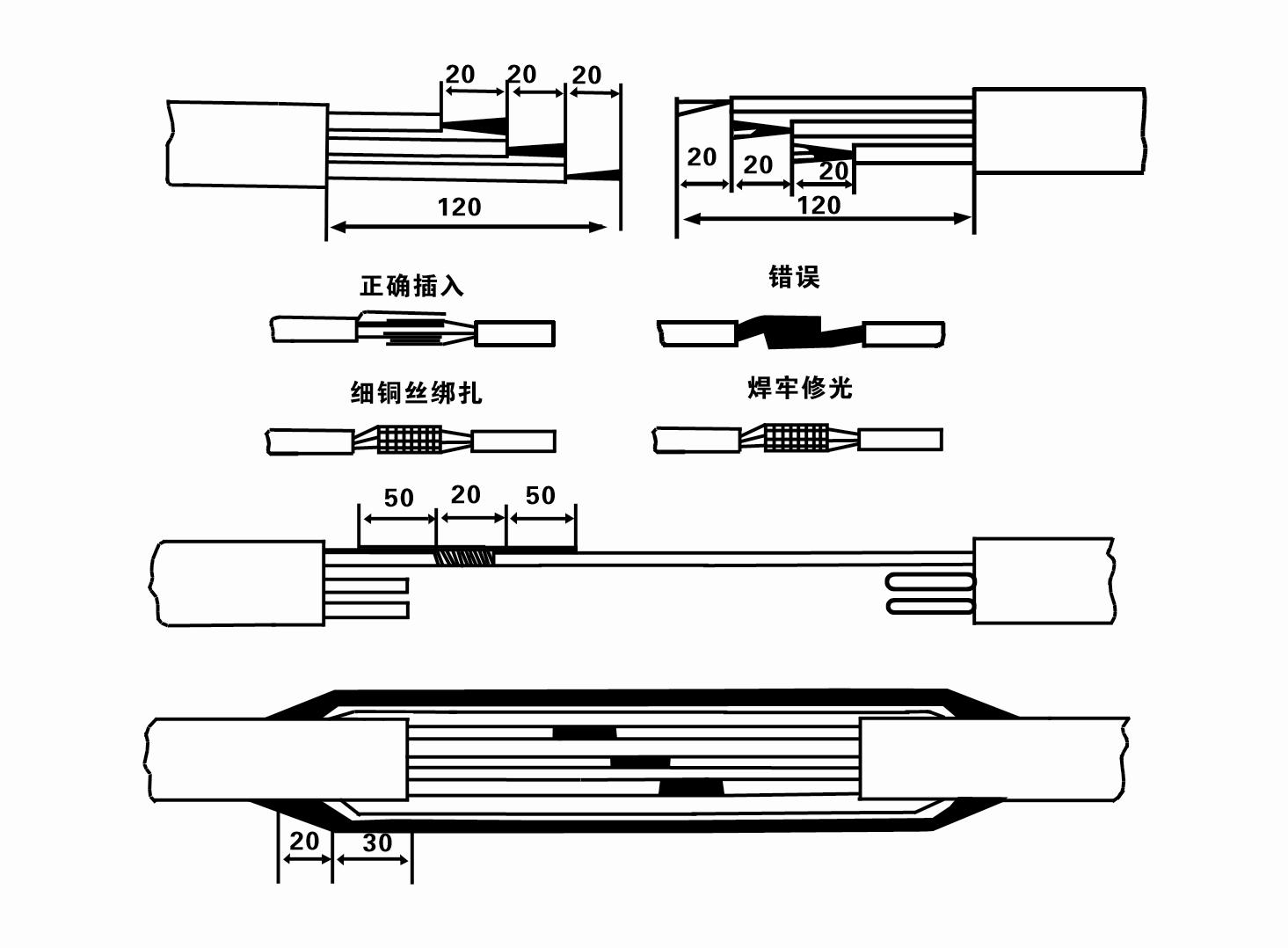
8. E hoʻohana i ka multimeter no ka nānā ʻana inā pili ʻia nā uea ʻekolu ʻāpana a inā ʻaʻole kaulike ke kūpaʻa DC.
9. E nānā inā ua hoʻonui ʻia ka mana kaapuni a me ka mea hoʻololi, a laila hoʻohui i ke kī hoʻomalu overload a i ʻole nā mea hoʻomaka. E nānā i ka Papa 2 no nā hi'ohi'ona kiko'ī, a laila, e ninini i ka bākeke wai i loko o ka pā wai mai ka puka wai e ho'oma'ama'a i ka pahu pahu i loko o ka pama, a laila e kau i ka pauma uwila i lalo i luna a pa'a. a e nānā inā pili ka hoʻokele me ka hōʻailona hoʻokele. Inā ʻaʻole, e hoʻololi i nā mea hoʻohui ʻelua o ke kaula ʻekolu. Inā hoʻohana ʻia i nā hanana kūikawā (e like me nā ʻauwai, nā ʻauwai, nā muliwai, nā loko, nā loko, a me nā mea ʻē aʻe), pono e hoʻopaʻa ʻia ka paila uila.
(2) Mea hoʻokomo a me nā mea hana:
1. Hoʻokahi mau kaulahao hāpai no ʻelua mau tona.
2. ʻO kahi tripod me ke kiʻekiʻe kū i lalo o ʻehā mau mika.
3. ʻElua kaula kau (wire ropes) hiki ke kaumaha i ke kaumaha ma mua o hoʻokahi tona (hiki ke halihali i ke kaumaha o ka pahu wai piha).
4. E hoʻouka i ʻelua mau paʻi (splints).
5. Nā wrenches, hammers, screwdrivers, uila a me nā mea kani, etc.
(3) Hoʻokomo ʻia ka pauma uila:
1. Hōʻike ʻia ke kiʻikuhi hoʻonohonoho o ka pauma uila submersible ma ka Figure 2. Hōʻike ʻia nā ana hoʻonohonoho kikoʻī ma ka Papa 3 "List of Installation Dimensions of the Submersible Electric Pump".
2. Hiki ke hoʻokiʻekiʻe pololei ʻia nā paila uila me ke poʻo ma lalo o 30 mika i loko o ka pūnāwai me ka hoʻohana ʻana i nā paipu a me nā kaula uwea a i ʻole nā kaula hemp ʻē aʻe e hiki ai ke halihali i ke kaumaha piha o ka mīkini holoʻokoʻa, nā paipu wai, a me ka wai i loko o nā paipu.
3. ʻO nā pumps me ke poʻo i ʻoi aku ma mua o 30 mika e hoʻohana i nā paipu kila, a penei ka hoʻonohonoho ʻana:
①E hoʻohana i kahi pipili no ka hoʻopaʻa ʻana i ka ʻaoʻao o luna o ka ʻaoʻao o ka pauma wai (ua hoʻopili ʻia ke kaʻa a me ka pauma wai i kēia manawa), e hoʻokiʻekiʻe me ke kaulahao e kau ana, a nakinaki mālie i loko o ka luawai a kau i ka paʻi ma ke poʻo punawai a wehe i ke kaulahao. kaulahao e kau ana.
② E hoʻohana i nā paipu ʻē aʻe e hoʻopaʻa i ka paipu, e hoʻokiʻekiʻe me ke kaulahao e kau ana ma kahi mamao o 15 knm mai ka lehelehe, a e hoʻohaʻahaʻa mālie. Ma waena o ka flange paipu a me ka flange pump E hoʻopaʻa i ka pā hao a hoʻopaʻa i ka paipu a paʻa pono me nā bolts, nati a me nā mea holoi puna.
③ E hoʻokiʻekiʻe iki i ka pauma hoʻohaʻahaʻa, e wehe i ke kaula ma ka ʻaoʻao o luna o ka pā wai, e hoʻopaʻa paʻa i ke kaula i ka paipu wai me ka lipine plastik, a nakinaki mālie i lalo a kau ʻia ka paʻi ma ka luawai.
④E hoʻohana i ke ʻano like e hoʻopaʻa ai i nā paipu wai a pau i loko o ka pūnāwai.
⑤Ma hope o ka hoʻopili ʻia ʻana o ke kaula alakaʻi i waho i ka hoʻololi mana, ua hoʻopili ʻia i ka lako mana ʻekolu.
(4) Nā mea e nānā ai i ka wā e hoʻokomo ai:
1. Inā ʻike ʻia kahi mea hoʻopuʻi i ka wā o ka pahū ʻana, e hoʻohuli a huki paha i ka paipu wai no ka lanakila ʻana i ke kiko pahu. Inā ʻaʻole e holo nā ʻano hana like ʻole, e ʻoluʻolu, mai hoʻoikaika i ka pamu i lalo e pale aku i ka pōʻino o ka pauma uila a me ka luawai.
2. I ka wā o ka hoʻokomo ʻana, pono e kau ʻia kahi pā hao ma ka ʻaoʻao o kēlā me kēia paipu a paʻa pono.
3. Ke hoʻohaʻahaʻa ʻia ka paila wai i loko o ka pūnāwai, pono e hoʻokomo ʻia i waenakonu o ka paipu pūnāwai i mea e pale ai i ka holo ʻana o ka pamu i ka paia o ka pūnāwai no ka manawa lōʻihi, e hoʻonāwaliwali ai ka pamu a e kahili a wela ke kaʻa. .
4. E hoʻoholo i ka hohonu o ka paila wai a hiki i lalo o ka luawai e like me ke kahe ʻana o ke one a me ka lepo o ka luawai. Mai kanu i ka pamu i ka lepo. ʻO ka mamao mai ka pā wai a hiki i lalo o ka pūnāwai ʻaʻole i emi iho ma mua o 3 mika (e nānā i ke Kiʻi 2).
5. ʻAʻole emi ka hohonu o ke komo ʻana o ka wai ma lalo o 1-1.5 mika mai ke kiʻekiʻe o ka wai ikaika a hiki i ka node inlet wai (e nānā i ke Kiʻi 2). Inā ʻaʻole, hiki ke pohō maʻalahi nā bearings pump wai.
6. ʻAʻole hiki ke haʻahaʻa loa ka hāpai ʻana o ka paila wai. A i ʻole, pono e hoʻokomo ʻia kahi valve puka ma luna o ka pipeline wai punawai e hoʻomalu i ke kahe ʻana o ka paila ma ka helu kahe i helu ʻia e pale ai i ka hoʻonui ʻia ʻana o ke kaʻa a puhi ʻia ma muli o nā kahe kahe nui.
7. I ka holo ana o ka pauma wai, pono e hoomau ka puka ana o ka wai a me ke ano, pono ke kupaa (ma lalo o na kulana hana i heluia, ma ke ano, aole oi aku mamua o 10% o ka manawa i heluia), a aole e haalulu a walawala. Inā loaʻa kekahi mea ʻino, pono ke kāpae ʻia ka mīkini e ʻike i ke kumu a hoʻopau.
8. I ka wā e hoʻokomo ai, e hoʻolohe i ka hoʻonohonoho ʻana o ka uea hoʻopaʻa ʻia kaʻa (e nānā i ke Kiʻi 2). Inā he paipu kila ka paipu wai, e alakaʻi iā ia mai ka puʻu punawai; inā he paipu plastik ka paipu wai, e alakaʻi iā ia mai ka hōʻailona kumu o ka paila uila.
(1)submersible pump installation is complete, re-check the insulation resistance and three-phase conduction from the switch, check the instrument and start the equipment connection error, if there is no problem, can start the trial, after the start of the instrument indicating readings whether more than the nameplate stipulated rated voltage and current, observe the pump noise and vibration phenomenon, everything is normal can be put into operation.
(2)pump operation for the first four hours, should be shut down quickly test the thermal insulation resistance of the motor, the value should not be less than 0.5 megaohm.
(3)pump shutdown, should be started after an interval of five minutes, to prevent the water column in the pipe has not completely reflux caused by excessive motor current and burnout.
(4)pump into normal operation,in order to prolong its service life, to check the supply voltage, working current and insulation resistance is normal, if found the following situation, should immediately shut down troubleshooting.
1 i ke kūlana helu, ʻoi aku ka nui o kēia manawa ma mua o 20%.
2 ka pae wai hoʻoikaika i ka ʻāpana komo wai, e hoʻoheheʻe ana i ka wai.
3 pauma submersible ha'alulu nui a wala'au paha.
ʻOi aku ka haʻahaʻa o ka volta 4 ma mua o 340 volts.
Hoʻopau ka fuse i kahi māhele.
6 poino paipu wai.
ʻO ka motika 7 i ke kūpaʻa insulation wela ma lalo o 0.5 megaohm.
(5)This product is a portable water pump, with the characteristics of easy disassembly, the user can disassemble and clean the various components according to the following steps to maintain the normal operation of the pump. First of all to untie the cable tie, remove the pipeline part and take off the line protection plate. Then unscrew the drain bolt, discharge all the water in the motor chamber. Then take off the filter, loosen the fixing screw on the coupling fixed motor shaft. Then unscrew the bolt connecting the water inlet section and the motor, the pump and the motor separation (pay attention to the device leveling when separating, to prevent the bending of the pump shaft). The sequence of disassembly of the pump is: water inlet section, impeller, guide housing, impeller, check valve body. When disassembling the impeller, use special tools to loosen the cone sleeve fixed the impeller. In the whole disassembly process, pay attention to avoid bending the pump shaft and damage various parts. The steps of motor disassembly are: put the motor on the platform, remove the nut, seat, shaft head lock nut, thrust plate, key, lower guide rail from the bottom in order (tie rod bolt), then remove the rotor (pay attention not to damage the wire packet), and finally remove the connecting section and the upper guide bearing seat. Before assembly, the rust and dirt of each part should be cleaned, and sealant should be applied to each mating surface and fastener, and then the assembly should be carried out in the opposite order of disassembly (the movement of the motor shaft after assembly is about 1 mm). After assembly, the coupling should be flexible, and then the filter should be put on for machine test. 6. Submersible electric pump should be taken out of the well for dismantling and maintenance according to Article 5 after operating for one year, or less than one year, but the diving time has reached two years, and the worn parts should be replaced.
1, e hoʻoheheʻe i ka wai i loko o ka lua kaʻa (ʻoi loa i ka hoʻoilo e pale ai i ka hau mai ka hau), a nakinaki maikaʻi i ke kaula.
2, store in an indoor room without corrosive substances and gases, with a temperature below 40 °C.
3, pono ka hoʻohana lōʻihi e hoʻolohe i ka pale ʻana i ka ʻōpala o nā paila submersible.
- Mea hoʻolele
- Puʻu lima
- Ka lima lāʻau lāʻau
-
apo apo
01 Hoʻokomo wai hohonu
02 Waiwai kiʻekiʻe
03 lako wai mauna
04 hale kiaʻi wai
05 Ka wai mahiai
06 ka hoʻoulu ʻana i ka māla
07 hoʻokomo wai kahawai
08 wai hale

